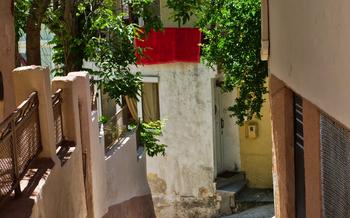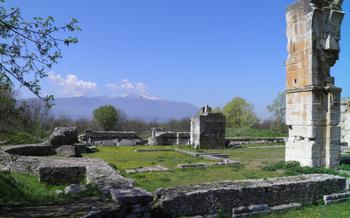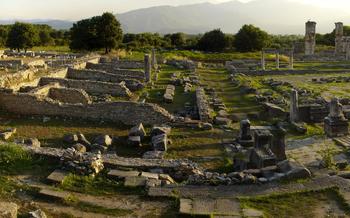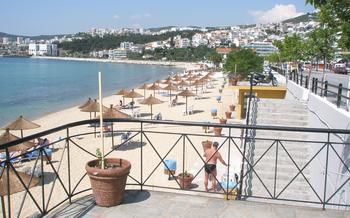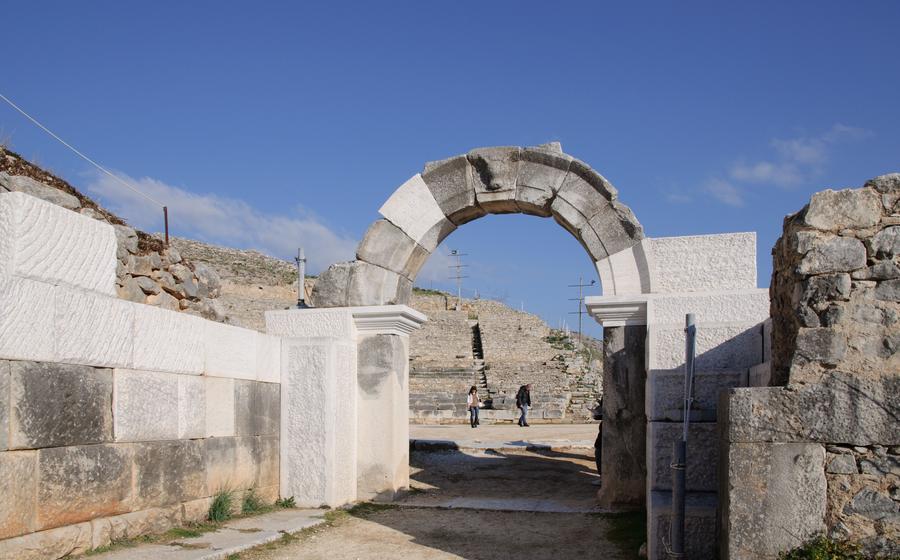
The Ancient Theatre of Philippi
- The Antiquity of Philippi: A Crossroads of History
- The Ancient Theatre
- Architectural Features:
- Multifunctional Venue:
- Remarkable Preservation:
- UNESCO Recognition:
- Excavations and Discoveries: Unearthing Philippi's Hidden Treasures
- The Via Egnatia: A Gateway to the East
- The Battle of Philippi: A Clash of Titans
- The Acropolis of Philippi: A Majestic Citadel
- The Baptistery: A Sacred Space for Early Christian Rituals
- The Wall Paintings:
- The Mosaics: A Vivid Tapestry of Ancient Art
- The mosaics of Philippi are a testament to the city's artistic prowess and cultural sophistication. These intricate works of art, meticulously crafted from tiny tesserae, adorn the floors, walls, and ceilings of both public and private spaces, adding a touch of splendor to the ancient city.
- The subjects depicted in the mosaics are as diverse as the city itself, ranging from mythological scenes to allegorical representations and everyday life. Gods and goddesses, heroes and heroines, animals, and geometric patterns come together to create a vibrant tapestry that tells stories, conveys messages, and reflects the beliefs and values of the ancient Philippians.
- The techniques and craftsmanship employed by the mosaic artists are nothing short of remarkable. Using a variety of colored stones, glass, and ceramic tiles, they created intricate designs with astonishing precision and detail. The resulting artworks are not only visually stunning but also incredibly durable, having withstood the test of time and the elements for centuries.
- The mosaics of Philippi offer a valuable glimpse into the artistic heritage of the ancient city. They provide insights into the religious beliefs, social customs, and cultural influences that shaped Philippian society. Whether depicting scenes from Greek mythology, Roman history, or early Christian iconography, these mosaics serve as a testament to the creativity and artistry of the Philippian people.
- Today, the mosaics of Philippi are carefully preserved and displayed in museums and archaeological sites throughout the region. Visitors can marvel at their beauty and craftsmanship, and appreciate the stories they tell about the rich and vibrant history of this ancient city.
- The Statues:
- The Ceramics:
- Insider Tips:
The Antiquity of Philippi: A Crossroads of History
Philippi, a prominent city in ancient Macedonia, holds a significant place in history. Its strategic location at the crossroads of major trade routes made it a melting pot of cultures and a center of commerce. Archaeological discoveries have unearthed a wealth of artifacts, shedding light on the city's rich and diverse past. From the legacy of Alexander the Great, who conquered the region in the 4th century BC, to the influence of his successors, the city flourished as a center of Hellenistic culture. Philippi's antiquity is a testament to its enduring importance throughout the ages, leaving an indelible mark on the tapestry of ancient Macedonia.
The Ancient Theatre
The Ancient Theatre of Philippi stands as a testament to the city's rich cultural heritage. Built in the 4th century BC, this impressive structure is a reminder of Philippi's significance as a center of Hellenistic civilization. The theatre's well-preserved remains allow visitors to step back in time and experience the grandeur of ancient performances.
Architectural Features:
The theatre is a marvel of ancient engineering, featuring a meticulously designed seating arrangement that accommodated up to 6,000 spectators. The tiers of seats rise in a semicircle, providing excellent views of the stage. The stage itself is adorned with intricate reliefs and sculptures, hinting at the elaborate productions that once graced this space.
Multifunctional Venue:
Beyond theatrical performances, the theatre served as a versatile venue for various gatherings. It hosted religious ceremonies, political assemblies, and civic events. The theatre's acoustics, renowned for their clarity and resonance, ensured that every word spoken on stage reached the farthest corners of the auditorium.
Remarkable Preservation:
Despite the passage of centuries, the theatre remains remarkably well-preserved, a testament to the quality of its construction. The seating arrangements, stage, and intricate carvings have withstood the ravages of time, offering visitors a glimpse into the grandeur of ancient Greek architecture.
UNESCO Recognition:
In recognition of its exceptional cultural and historical value, the Ancient Theatre of Philippi has been designated as a UNESCO World Heritage Site. This prestigious recognition underscores the theatre's significance as a symbol of Philippi's rich past and its enduring legacy in the realm of ancient Greek theatre.
Excavations and Discoveries: Unearthing Philippi's Hidden Treasures
Archaeological excavations at Philippi have been ongoing for over a century, revealing a wealth of significant artifacts and structures that shed light on the city's rich past. These excavations have uncovered impressive remains of the ancient city, including the Agora, the marketplace, a vital center of daily life in ancient Philippi. The Agora, with its shops, stoas (covered walkways), and public buildings, provided a vibrant space for trade, commerce, and social interaction.
Among the notable discoveries at Philippi is the impressive collection of sculptures, mosaics, and inscriptions. These artifacts offer valuable insights into the artistic and cultural heritage of the city. The sculptures, often depicting gods, goddesses, and prominent figures, showcase the skill and artistry of ancient Greek and Roman sculptors. The mosaics, with their intricate designs and vivid colors, adorn floors, walls, and ceilings, adding beauty and opulence to both public and private spaces. Inscriptions, etched in stone or metal, provide valuable historical information, including names, dates, and details of events that occurred in ancient Philippi.
The ongoing archaeological efforts at Philippi are crucial in preserving and studying the city's archaeological treasures. These excavations continue to contribute to our understanding of Philippi's urban planning, architecture, and daily life, providing valuable insights into the history and culture of this ancient Macedonian city.
The Via Egnatia: A Gateway to the East
The Via E played a pivotal role in connecting the East and West. Traversing the Balkans from the Adriatic coast to the Bosporus Strait, the Via Egnatia served as a vital artery for trade and communication, facilitating the movement of goods, ideas, and people across a vast expanse of territory.
Philippi, strategically situated along this ancient thoroughfare, thrived as a major stopover for travelers and traders. The city's location at the crossroads of the Via Egnatia and other regional routes transformed it into a bustling hub, where diverse cultures and influences converged.
The construction of the Via Egnatia was a remarkable feat of Roman engineering. Its meticulously planned route, spanning over 500 miles, required the construction of bridges, tunnels, and milestones to ensure safe and efficient travel. The road's durability and longevity stand as a testament to the engineering prowess of the Roman Empire.
Beyond its practical significance, the Via Egnatia acted as a catalyst for cultural exchange. The movement of people and goods along the road facilitated the spread of ideas, artistic styles, and religious beliefs. As a result, Philippi became a melting pot of cultures, where Greek, Roman, and Eastern influences blended to create a unique and vibrant society.
The historical importance of the Via Egnatia cannot be overstated. It served as a lifeline for trade and communication, connecting the Roman Empire with its eastern provinces and beyond. The road played a crucial role in the expansion of Roman power and influence, fostering economic prosperity and cultural exchange throughout the region.
The Battle of Philippi: A Clash of Titans
In 42 BC, the plains of Philippi witnessed a pivotal clash that would shape the course of Roman history - the Battle of Philippi. This epic confrontation pitted the forces of the Roman Republic, led by Brutus and Cassius, against the combined armies of Mark Antony and Octavian, who would later become the first Roman emperor, Augustus.
The Battle of Philippi was not merely a military conflict; it was a struggle for power and ideology. Brutus and Cassius, staunch republicans, sought to uphold the traditional values and institutions of the Roman Republic. Antony and Octavian, on the other hand, represented the emerging imperial order, promising stability and a new era of prosperity.
The battle unfolded in two stages. In the first encounter, Brutus defeated Octavian's forces, while Antony's troops routed Cassius's legions. However, in the second clash, Antony and Octavian's combined forces overwhelmed Brutus's army, leading to the defeat of the republican cause.
The Battle of Philippi marked a turning point in Roman history. It paved the way for the rise of Octavian, who would go on to establish the Roman Empire. The battle also signaled the end of the Roman Republic, a system of government that had endured for over 500 years.
Today, the battlefield of Philippi stands as a solemn reminder of this momentous event. Visitors can explore the site and immerse themselves in the history of this epic struggle that forever altered the course of Western civilization.
The Acropolis of Philippi: A Majestic Citadel
Perched atop a hill overlooking the ancient city, the Acropolis of Philippi stands as a testament to the strategic importance and grandeur of this once-thriving metropolis. As you ascend the winding path towards the summit, you'll be greeted by awe-inspiring views of the surrounding countryside, stretching from the Aegean Sea to the distant mountains.
The Acropolis served as the fortified upper city of Philippi, providing a safe haven for its inhabitants during times of conflict. Within its walls, you'll discover the remnants of temples, fortifications, and other structures that once defined the city's skyline. These ruins offer a glimpse into the architectural prowess and cultural heritage of the ancient Macedonians.
Among the notable structures on the Acropolis is the Temple of Athena Polias, dedicated to the patron goddess of the city. Although only fragments of the temple remain, its once-magnificent columns and intricate carvings hint at its former glory. The Acropolis also features the remains of a theater, where citizens gathered to witness performances and public events.
Ongoing excavations and restoration efforts are continuously shedding light on the rich history of the Acropolis. As you explore this ancient citadel, you'll be transported back in time, imagining the bustling streets, the vibrant religious ceremonies, and the strategic decisions that shaped the fate of Philippi.
The Baptistery: A Sacred Space for Early Christian Rituals
Nestled amidst the ruins of ancient Philippi, the Baptistery stands as a testament to the early Christian community's devotion and religious practices. This unique structure, dating back to the 5th century AD, served as a sacred space dedicated to the sacrament of baptism, a crucial rite of passage in the Christian faith.
The Baptistery's well-preserved baptismal font, a large, circular basin, takes center stage within the building. This font, intricately carved from a single block of white marble, symbolizes the spiritual rebirth and purification experienced through baptism. Believers would immerse themselves in the water, following the teachings of Jesus Christ and the apostles.
The walls of the Baptistery are adorned with stunning mosaics, adding a vibrant and symbolic dimension to the space. These mosaics depict scenes from the Bible, including the baptism of Jesus by John the Baptist in the Jordan River. The vivid colors and intricate details of the mosaics bring the stories to life, creating a visually captivating environment for those seeking spiritual guidance and renewal.
The Baptistery holds immense historical significance as a tangible link to the early Christian community in Philippi. It represents the deep-rooted faith and commitment of the Philippian Christians, who gathered in this sacred space to celebrate their beliefs and strengthen their connection with God. The Baptistery serves as a reminder of the enduring legacy of Christianity in Philippi and its role as a center of religious activity in the ancient world.
The Wall Paintings:
During excavations in Philippi, archaeologists have uncovered vibrant and well-preserved wall paintings that offer a glimpse into the artistic traditions and cultural influences of the ancient city. These paintings adorn the walls of various structures, including houses, public buildings, and religious spaces.
The subjects depicted in the paintings are diverse, ranging from religious scenes and mythological figures to representations of everyday life. The artists employed a variety of techniques and styles, including fresco, tempera, and encaustic, to create these colorful and expressive works of art.
One notable example is the painting of the "Baptism of Christ," found in the Baptistery. This intricate and well-preserved fresco depicts the moment when John the Baptist baptizes Jesus in the Jordan River. The painting is notable for its vivid colors, detailed composition, and symbolic representation of the Christian sacrament of baptism.
Other wall paintings feature scenes from Greek mythology, such as the labors of Hercules or the adventures of Odysseus. These paintings demonstrate the influence of classical Greek culture on the artistic traditions of Philippi.
The wall paintings of Philippi offer valuable insights into the religious beliefs, cultural values, and artistic expressions of the ancient city's inhabitants. Ongoing conservation efforts aim to preserve these precious works of art and ensure their continued accessibility for future generations.
The Mosaics: A Vivid Tapestry of Ancient Art
The mosaics of Philippi are a testament to the city's artistic prowess and cultural sophistication. These intricate works of art, meticulously crafted from tiny tesserae, adorn the floors, walls, and ceilings of both public and private spaces, adding a touch of splendor to the ancient city.
The subjects depicted in the mosaics are as diverse as the city itself, ranging from mythological scenes to allegorical representations and everyday life. Gods and goddesses, heroes and heroines, animals, and geometric patterns come together to create a vibrant tapestry that tells stories, conveys messages, and reflects the beliefs and values of the ancient Philippians.
The techniques and craftsmanship employed by the mosaic artists are nothing short of remarkable. Using a variety of colored stones, glass, and ceramic tiles, they created intricate designs with astonishing precision and detail. The resulting artworks are not only visually stunning but also incredibly durable, having withstood the test of time and the elements for centuries.
The mosaics of Philippi offer a valuable glimpse into the artistic heritage of the ancient city. They provide insights into the religious beliefs, social customs, and cultural influences that shaped Philippian society. Whether depicting scenes from Greek mythology, Roman history, or early Christian iconography, these mosaics serve as a testament to the creativity and artistry of the Philippian people.
Today, the mosaics of Philippi are carefully preserved and displayed in museums and archaeological sites throughout the region. Visitors can marvel at their beauty and craftsmanship, and appreciate the stories they tell about the rich and vibrant history of this ancient city.
The Statues:
Archaeological excavations at Philippi have yielded a treasure trove of statues, providing valuable insights into the artistic traditions and cultural heritage of the ancient city. These statues, ranging from life-size sculptures to smaller figurines, depict a diverse array of subjects, including gods, goddesses, emperors, and ordinary citizens.
The statues discovered in Philippi are significant for several reasons:
Artistic Styles and Techniques: The statues showcase a variety of artistic styles and techniques, reflecting the influence of different periods and cultures. Some statues exhibit the classical realism and idealized forms characteristic of Greek art, while others display the more expressive and dynamic style of the Hellenistic period. The statues also reveal the skill and craftsmanship of the sculptors, who used various techniques such as carving, modeling, and casting to create their works.
Historical Insights: The statues provide valuable historical insights into the religious beliefs, social customs, and cultural values of ancient Philippi. The depictions of gods and goddesses offer glimpses into the religious practices and mythology of the ancient Greeks and Romans. Statues of emperors and other prominent figures shed light on the political and social hierarchy of the city. Furthermore, statues depicting ordinary citizens provide a glimpse into the everyday lives and social interactions of the people of Philippi.
Symbolism and Meaning: Many of the statues found in Philippi carry symbolic meanings and convey specific messages. For example, statues of gods and goddesses were often used to represent divine power and protection. Statues of emperors were used to honor and commemorate their achievements and to reinforce their authority. Statues of ordinary citizens could serve as memorials or as representations of specific individuals or families.
The statues of Philippi stand as testaments to the artistic and cultural achievements of the ancient city. They offer a glimpse into the lives, beliefs, and values of the people who inhabited this vibrant and cosmopolitan center.
The Ceramics:
Excavations at Philippi have yielded an abundance of ceramic artifacts, providing valuable insights into the daily lives, economic activities, and artistic traditions of the ancient city. From utilitarian vessels used for food preparation and storage to decorative objects adorning homes and public spaces, the ceramics of Philippi offer a glimpse into the material culture of its inhabitants.
The diverse forms and functions of the ceramics are a testament to the skill and ingenuity of Philippi's potters. Cooking pots, amphorae for storing wine and oil, plates, bowls, and cups were essential items in every household. Roof tiles, often decorated with intricate patterns, protected buildings from the elements. Figurines depicting gods, goddesses, and animals served as religious objects or decorative accents.
The techniques used in the production of ceramics in Philippi were varied and sophisticated. Potters employed wheel-throwing, molding, and firing techniques to create their works. Wheel-thrown vessels were shaped on a rapidly spinning potter's wheel, allowing for the creation of symmetrical and evenly shaped objects. Molding was used to produce more complex forms, such as figurines and decorative tiles. The final step in the ceramic-making process was firing, which involved heating the clay objects in a kiln to high temperatures to harden and strengthen them.
The study of Philippi's ceramics has shed light on the city's economic activities and trade networks. The presence of imported ceramics from other regions of Greece and the Mediterranean indicates that Philippi was a vibrant commercial center with connections to the wider world. Local potters also produced ceramics for export, contributing to the city's economy.
The ceramics of Philippi are not merely functional objects but also works of art. Many vessels and figurines are decorated with intricate patterns, painted designs, and figural motifs. These decorative elements reflect the artistic sensibilities of Philippi's potters and provide a glimpse into the city's cultural heritage.
Insider Tips:
For the most enjoyable experience in Philippi, plan your visit during the shoulder seasons of spring and autumn. During these times, you can avoid the sweltering summer heat and the large crowds that flock to the site in the peak season. Philippi's mild temperatures and fewer tourists make it ideal for a leisurely exploration of its ancient wonders.
To delve deeper into the history and significance of Philippi, consider booking a guided tour. Knowledgeable guides can provide insights into the site's past, uncovering hidden details and stories that might otherwise go unnoticed. They can also help you navigate the extensive ruins and ensure you don't miss any of the essential highlights.
While in the region, don't miss the chance to visit the nearby town of Kavala. This charming coastal city boasts a picturesque old town, a vibrant harbor, and stunning views of the Aegean Sea. Take a stroll through its cobblestone streets, admire the traditional architecture, and savor the delicious seafood delicacies offered by the local tavernas. Kavala is the perfect complement to your exploration of Philippi, offering a blend of history, culture, and natural beauty.

